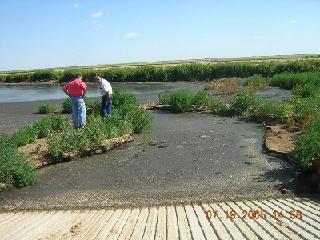


| |
LiquiDredge Enzyme ComplexLiquiDredge breaks down organic solids in wastewater ponds which cause odors and sludge buildup. LiquiDredge is suitable for waste ponds in municipalities, dairies, poultry, industrial projects, grain industry, hog farms, and slaughter industries.No additional bacteria are added. LiquiDredge is made of powerful enzymes harvested from bio-reactors. The resulting enzymes can then be provided without introducing foreign organisms which would compete with the native symbiotic balance. LiquiDredge enzymes provide a metabolic path where native micro-organism colonies will re-establish symbiosis. LiquiDredge will revive micro-organisms which have lain dormant due to hostile conditions. As the quantity of stagnate solids are reduced the noxious odors (including Hydrogen Sulfide) are also greatly reduced. • Reduce long term expense and resources allocated to waste management • You won't have to dredge if your solids are placed in suspension, where you can pump them to the crops • You won't damage your pond lining by dredging • Dissolves lagoon solids with enzymes and allows native bacteria and algae decompose it • Will not alter your pond chemistries since it relies upon your native bacteria and algae to restore balance • Will dissolve the manure solids and place them in solution to be dispersed in nutrient rich water which will not burn crops. • Reduce complex Nitrates to make available nitrogen to your crops • Reduce complaints from the neighbors during watering or pumping • Works with or without aeration. Requires less product if aeration is provided • Available in 5/35/55/275 gallon containers @ $3/gallon (plus shipping, volume discounts may apply) • Most ponds treated between $800 and $1800 per month The Short ExplanationSome waste ponds smell bad and fill up with waste. If you kept them wet and gave them enough time, nature would eventually correct the problem. Since this is not practical, you are stuck paying for a dredge to stay on schedule.Micro-organisms (such as fungus, bacteria and algae) normally consume waste. Since micro-organisms donít have mouths, they must dissolve food using enzymes and absorb the nutrients back through their cell walls. If your pond is overwhelmed by volume, you still have all the right kinds of micro-organisms, they just canít produce enough enzymes to keep up with the incoming waste flow. Many pond products treat the symptom by adding more bacteria to the ponds. Any benefits experienced from these bacteria are a result of the enzymes they generate. LiquiDredge treats the problem by adding more enzymes than just the bacteria could possibly generate during their short existence in a hostile environment. Our enzyme products differ from others. We donít try to identify missing enzymes and specifically target them. Instead, we grow fully symbiotic systems, balanced naturally over time. We then concentrate the enzyme products. This allows us to provide the full spectrum of enzymes which nature would have provided, if given enough time. Additional PerspectiveThe complex biological systems which naturally purify the earth have evolved over millions of years. Natural processes have been optimized by evolution. While man has successfully employed enzymes for thousands of years, the classification and biochemical comprehension of enzymes is still a relatively new science. While singular enzyme isolation has proven invaluable, complex enzyme development is providing even greater benefits to industry.We are able to produce complex enzyme products harvested from balanced symbiotic systems. These symbiotic systems provide a unique mixture, in the desird ratios (protease, cellulose, lipase, etc.) which are more robust and better suited for wastes in a wide range of environments. The symbiotic link between micro-organisms is predominantly a food-for-shelter trade. While waste treatments often focus on the metabolic path (the food side of the trade), the shelter component is often the root of the problem. If a single link in the symbiotic chain is not sufficiently protected by a metabolically adjacent micro-organism, the symbiotic metabolic path will become inefficient and encumbered. If more bacteria are added to an imbalanced symbiotic system, the organisms will temporarily provide beneficial enzymes to the metabolic path but will soon succumb to the hostile accumulations which overwhelmed their predecessors. While enzymatic treatment effects must also be eventually overwhelmed, the effects of the enzyme complex are more pronounced as they provide a sheltered environment for the entire symbiotic chain to recover and produce their own enzymes. The effect will then gain biological momentum whi.ch will continue to work between scheduled enzyme infusions. Noted changes to the pond are recognizable within the first two weeks of the initial treatment. Most notabley, the biological erruptions from the pond basin will grow larger and more frequent. In many cases, 'bricks' of waste will accumulate around the edges of the pond until they are consumed. |




|